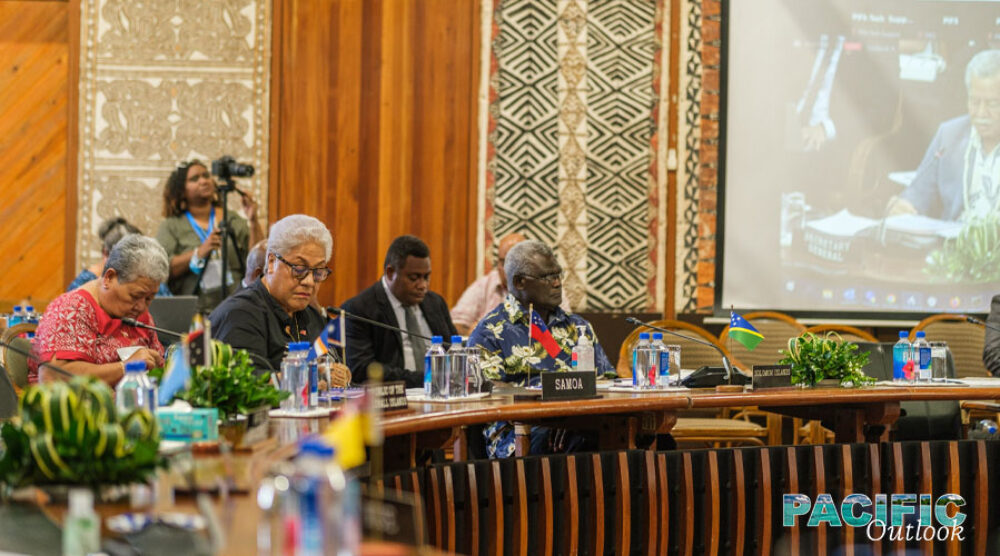Dame Meg Taylor has written a recent thoughtful analysis on threats to Pacific-led regionalism from Beijing and Washington DC’s renewed Pacific focus. Taylor—more than well-placed to speak on regional affairs—is concerned that Pacific “unity is deeply challenged and undermined by the encroaching influence of competing geopolitical agendas.”
On one side is the West and its “traditional, defence-centric understanding of security.” On the other is China, which suffers from “cultural tensions” among Pacific audiences, stemming from its economically-charged regional business behaviours. Both are “incompatible with Blue Pacific priorities and values,” Taylor claims, entrenching “dependency and militarization,” while also running counter to the Blue Pacific identity, which Taylor elevates as of “paramount importance” to the region between now and 2050.
In this two-part article, I respectfully offer another perspective—a framework of opportunity that focuses on Pacific nations and citizens leveraging geostrategic agendas to realise sub-regional, national and community goals.
Great power competition offers a time for Pacific communities to think of these moments as unprecedented but not threatening. It could mean if realised, sustained moments for ‘reverse statecraft’—Pacific nations channelling external geostrategic interests into local people-led outcomes, realising, in particular, the Strategic Pathways listed within the Blue Pacific Vision. It could also see Pacific Island Countries (PICs) taking the lead in offsetting great power conflict through on-ground examples of ‘strategic cooperation’ between Beijing and Washington DC, especially through climate-change initiatives.
I sense a framework would begin with three themes. The first – and most fundamental – is acknowledging values.
In addition to Western values being regionally “incompatible,” Taylor observes that the language of a ‘free and open’ Pacific—cited by US Presidents and other Western leaders—can be used “to bully and projects the United States as the leader of the free and open democratic order across a super-region from the United States to Africa.”
But is this fair?
The Blue Pacific 2050 Strategy clearly articulates shared Pacific values, which cover regional cooperation and combined commitment, through to pluralism, security, and democratic values and principles. Both Pacific and Western leaders call upon and cite similar themes when discussing regional links. Indeed, the basis for Australia’s pivotal 2016 Pacific ‘Step up’, according to Malcolm Turnbull, was not only a genuine offer for greater connectivity, integration and trade, but fundamentally driven by “freedom, democracy, the rule of law, mutual respect.”
Such sentiment, I feel, is not manufactured but animated by a reality that PICs, like Australia, the US and Great Britain, are proud democracies. Granted, the Australia-United Kingdom-United States (AUKUS) deal was inked with security and the Pacific clearly in mind. But to exclusively look at AUKUS, at the expense of products like the US Pacific Partnership Strategy, does not give full thrust to the nature of what can emerge from a Pacific-led regionalism.
This, I fear, is what Taylor has done—over-emphasised a traditional security approach from Western nations while under-emphasising the non-security elements of such engagement, further leaving aside shared values-led commitments between the so-called West and PICs.
Had Taylor given space for such things, I sense her critique of “incompatible” Western values may not have been so sharp. US Secretary of State Anthony Blinken, for example, when laying the foundations for revamped Pacific efforts in early 2022, spoke firmly about “authentic engagement that speaks to the real needs of the islanders,” and for the “US to include on the agenda items that Pacific countries have identified as priorities for them [italics mine].” While tangible outputs have been slow to materialise—such as Kamala Harris’ pledge to triple regional fisheries funding—the emphasis on values is fundamental.
The same values-led relationships, frankly, cannot be said for Beijing, whose attempts Taylor acknowledges are chequered by perceptions of excessive commerciality. Soft power indices are never perfect measures of perception, but they have not been kind to Beijing’s attempts at influence in the region over the past few years.
Indeed, the RAND Corporation’s Derek Grossman more recently pointed to the PRC’s two “unforced errors” in its recent attempted 2022 ‘step up’—the immediate concerns expressed by Samoan Prime Minister Fiame Naomi Mata’afa over the draft US-Solomons Security Pact, as well as Beijing’s desire to work outside of the PIF, which provoked even more vocal condemnation by Micronesian President David Panuelo.
It is difficult to decouple these reactions to the fundamental nature of values, and the fluency Western and Pacific leaders exchange rather easily in public forums when developing new regional agreements. This does not mean consistent agreement and alignment on every issue. But values, as noted earlier, are fundamental.
While readers may note my analysis may place Pacific nations on the ‘Western’ side of the ledger, there is a minor irony here—it only enhances the choices of Pacific states to make non-Western links, especially in the service of interests. It also lays the foundations for strategic cooperation and capabilities—two other fundamentals for a Pacific-led regionalism in our age of strategic competition.
The next article examines how Pacific nations can play a fundamental role in decreasing global tensions by leading strategic cooperation, while also developing capabilities.
Sean Jacobs is a Port Moresby-born Australian writer and government relations and policy specialist.








